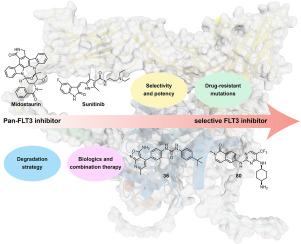新一代FLT3抑制剂在急性髓系白血病中的合理设计:从实验室到临床
IF 5.9
2区 医学
Q1 CHEMISTRY, MEDICINAL
引用次数: 0
摘要
fms样酪氨酸激酶-3 (FLT3)的激活突变是急性髓性白血病(AML)中最常见的遗传改变之一,影响约30%的患者并导致预后不良。flt3靶向抑制剂的开发取得了重大进展。第一代多激酶抑制剂如米多舒林和第二代药物如吉特替尼和奎兹替尼已经取得了成功。然而,通常由D835Y和F691L看门人突变引起的耐药性仍然是主要的挑战。为此,新一代FLT3抑制剂(FLT3i)被设计用于同时靶向FLT3内部串联重复(ITD)和酪氨酸激酶结构域(TKD)突变。本文综述了FLT3在AML调控中的机制,并回顾了过去五年来新型FLT3i的临床前研究。它讨论了这些药物,包括像STI-8591这样的小分子药物,化合物36和80,以及CLN-049和ssenti202等新的治疗策略,是如何设计来对抗耐药性的。目的是提供一个药物化学的角度,为新型小分子FLT3i的设计提供见解。本文章由计算机程序翻译,如有差异,请以英文原文为准。


Rational design of next-generation FLT3 inhibitors in acute myeloid leukemia: From laboratory to clinics
Activating mutations of FMS-like tyrosine kinase-3 (FLT3) are among the most common genetic alterations in acute myeloid leukemia (AML), affecting approximately 30 % of patients and leading to a poor prognosis. The development of FLT3-targeted inhibitors has achieved significant progress. First-generation multi-kinase inhibitors like midostaurin and second-generation agents such as gilteritinib and quizartinib have shown success. However, drug resistance, often due to D835Y and F691L gatekeeper mutations, remains a major challenge. In response, a new generation of FLT3 inhibitors (FLT3i) have been designed to simultaneously target both FLT3 internal tandem duplication (ITD) and tyrosine kinase domain (TKD) mutations. This review examines the mechanisms of FLT3 in the regulation of AML and examines preclinical research on novel FLT3i over the past five years. It discusses how these agents, including small-molecule like STI-8591, compounds 36 and 80 and novel therapeutic strategies such as CLN-049, and SENTI-202, are designed to combat resistance. The goal is to provide a medicinal chemistry perspective to provide insights for the design of novel small-molecule FLT3i.
求助全文
通过发布文献求助,成功后即可免费获取论文全文。
去求助
来源期刊
CiteScore
11.70
自引率
9.00%
发文量
863
审稿时长
29 days
期刊介绍:
The European Journal of Medicinal Chemistry is a global journal that publishes studies on all aspects of medicinal chemistry. It provides a medium for publication of original papers and also welcomes critical review papers.
A typical paper would report on the organic synthesis, characterization and pharmacological evaluation of compounds. Other topics of interest are drug design, QSAR, molecular modeling, drug-receptor interactions, molecular aspects of drug metabolism, prodrug synthesis and drug targeting. The journal expects manuscripts to present the rational for a study, provide insight into the design of compounds or understanding of mechanism, or clarify the targets.

 求助内容:
求助内容: 应助结果提醒方式:
应助结果提醒方式:


